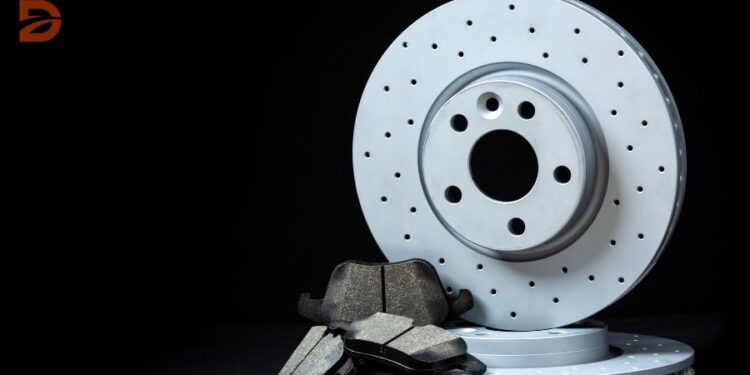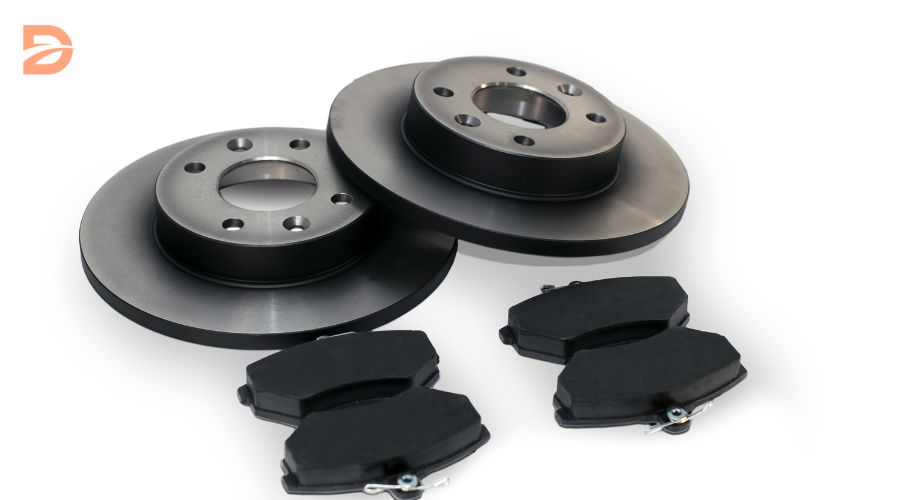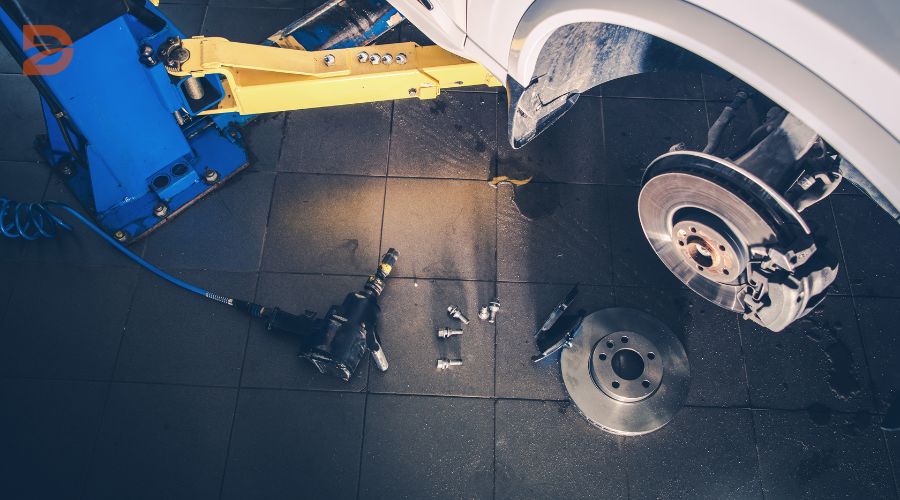When it comes to enhancing the safety and performance of your vehicle, upgrading the braking system is a crucial step. Brakes are a fundamental component of vehicle safety, ensuring that you can stop effectively under various conditions. This article will explore the top brake upgrades that can significantly enhance both safety and performance, including high-performance brake pads, performance brake rotors, stainless steel brake lines, high-performance brake fluid, and big brake kits.
Have you ever wondered how you can improve your vehicle’s braking capabilities and overall safety? The answer lies in strategic brake upgrades that go beyond the stock components. By investing in high-quality, performance-oriented brake parts, you can unlock the true potential of your vehicle’s stopping power, ensuring you’re prepared to handle any driving situation with confidence.
Key Takeaways
- Upgrading to high-performance brake pads can enhance friction, heat resistance, and durability for improved braking performance.
- Performance brake rotors can dissipate heat more effectively, reducing the risk of brake fade and enhancing overall braking efficiency.
- Stainless steel brake lines, high-performance brake fluid, and big brake kits can further improve your vehicle’s braking capabilities and safety.
- Brake system upgrades are crucial for enthusiasts or those who regularly engage in spirited driving, track days, or towing heavy loads.
- Choosing the right brake components can provide a noticeable difference in your vehicle’s braking performance and overall safety.
High-Performance Brake Pads
High-performance brake pads are designed to provide superior stopping power compared to standard pads, offering improved braking performance and reduced brake fade. These specialized pads are engineered to withstand extreme conditions and deliver consistent braking, even under the most demanding driving situations.
Benefits of High-Performance Brake Pads
High-performance brake pads are typically made from materials such as ceramic, carbon-fiber composites, or semi-metallic compounds. These advanced materials offer superior friction characteristics, allowing for shorter stopping distances and better performance under high-temperature conditions. Additionally, high-performance pads tend to have better heat dissipation properties, which reduces the likelihood of brake fades during intense driving scenarios, such as track days or spirited driving on twisty roads.
Potential Drawbacks of High-Performance Brake Pads
While the increased performance of high-performance brake pads is undeniable, it does come at a cost. These specialized pads can wear down brake rotors more quickly due to their abrasive nature, and they are generally more expensive than standard brake pads. Drivers must weigh the benefits of enhanced braking against the potential for increased maintenance and replacement costs when considering a high-performance brake pad upgrade.
| Brake Pad Type | Friction Characteristics | Noise and Dust | Lifespan |
|---|---|---|---|
| Organic | Moderate | Low | High |
| Ceramic | High | Low | Moderate |
| Semi-Metallic | High | Moderate | Moderate |
Performance Brake Rotors
Upgrading to performance brake rotors can enhance your vehicle’s braking efficiency and heat dissipation capabilities, reducing the risk of brake fade. These rotors offer several benefits that make them a worthwhile investment for those seeking to improve their vehicle’s overall braking performance.
Benefits of Performance Brake Rotors
Improved Heat Management: Performance brake rotors are designed to offer better heat management, contributing to increased resistance to warping. This is particularly important during demanding driving conditions or when towing heavy loads, as the braking system is subjected to higher temperatures.
Enhanced Wet Weather Performance: Upgrading to performance brake rotors can enhance braking performance in wet conditions. Slotted and drilled designs help to channel water and debris away from the braking surface, improving grip and reducing the risk of hydroplaning.
Increased Durability: Advanced brake rotors are known for their resistance to warping and enhanced durability, even under demanding driving conditions. This can lead to extended service life and reduced maintenance costs over time.
| Benefit | Explanation |
|---|---|
| Improved Stopping Power | Upgrading to high-performance brake pads can significantly enhance stopping power. |
| Reduced Braking Distances | Upgraded brake rotors can contribute to reducing braking distances. |
| Heat Dissipation Improvement | Advanced brake rotors are designed to offer improved heat dissipation properties. |
| Resistance to Warping | Upgraded brake rotors are known for their resistance to warping even under demanding driving conditions. |
While performance brake rotors offer many advantages, it’s important to note that they come with a higher cost compared to standard rotors. Additionally, their more aggressive surfaces can potentially lead to increased wear on brake pads, requiring more frequent replacements. Careful consideration of your driving needs and budget is essential when deciding to upgrade your vehicle’s braking components.
Brake upgrades, safety improvements
Upgrading key components of your vehicle’s braking system can significantly enhance its overall safety and performance. From stainless steel brake lines to high-performance brake fluid and big brake kits (BBKs), these upgrades can provide substantial benefits that go beyond just improved stopping power.
Stainless Steel Brake Lines
Stainless steel brake lines offer improved brake pedal feel and responsiveness by reducing flex compared to standard rubber brake lines. They are also more durable and resistant to corrosion, ensuring a more reliable braking system over time.
High-Performance Brake Fluid
Upgrading to high-performance brake fluid can improve the reliability and performance of your braking system, particularly in high-temperature conditions. These fluids have higher boiling points than standard fluids, which helps to prevent brake fade and maintain consistent braking power even under extreme conditions.
Big Brake Kits (BBKs)
Big brake kits (BBKs) represent the pinnacle of brake upgrades, offering substantial improvements in stopping power and heat management. These kits typically feature larger rotors, multi-piston calipers, and performance brake pads, all working together to provide enhanced braking performance. While these upgrades come with higher costs and potential installation challenges, the enhanced braking performance can be well worth the investment, especially for those who demand the best from their vehicles.
| Brake Upgrade | Key Benefits | Potential Drawbacks |
|---|---|---|
| Stainless Steel Brake Lines |
|
|
| High-Performance Brake Fluid |
|
|
| Big Brake Kits (BBKs) |
|
|
By upgrading components like stainless steel brake lines, high-performance brake fluid, and big brake kits, you can significantly enhance your vehicle’s braking capabilities, contributing to improved safety and a more confident driving experience, particularly in demanding situations or high-performance driving scenarios.
Brake System Components Overview
Unraveling the intricacies of a vehicle’s braking system is crucial for understanding how to enhance its performance and safety. This section delves into the key components that work in harmony to bring your car to a stop.
Brake Calipers
Brake calipers are the clamping force behind the braking system. They come in various configurations, including floating, sliding, and fixed calipers, each offering unique performance characteristics. Floating calipers allow the caliper to move laterally, providing even pad wear, while sliding calipers are designed for smooth, responsive braking. Fixed calipers, on the other hand, are typically found on high-performance vehicles, delivering exceptional braking power.
Brake Rotors
Brake rotors, also known as discs, are the circular components that the brake pads grip to slow down the vehicle. They can be either blank or drilled/slotted, with the latter design offering improved heat dissipation for better braking performance during heavy use.
Brake Pads
Brake pads are the friction material that makes contact with the rotors, generating the necessary force to slow down or stop the vehicle. They come in various material compositions, such as semi-metallic, organic, and ceramic, each with its advantages. Semi-metallic pads offer enhanced durability and consistent performance, organic pads provide a smoother, quieter braking experience, while ceramic pads excel in high-temperature situations.
Brake Hoses and Lines
The brake hoses and lines are the conduits that transfer the hydraulic pressure from the master cylinder to the brake calipers. They can be made of either rubber or braided alloy, with the latter offering a more rigid and responsive braking feel.
| Component | Description | Advantages |
|---|---|---|
| Brake Calipers | The clamping force of the braking system | Floating, sliding, and fixed calipers offer different performance characteristics |
| Brake Rotors | The circular components that the brake pads grip to slow down the vehicle | Blank or drilled/slotted design, the latter providing improved heat dissipation |
| Brake Pads | The friction material that makes contact with the rotors | Semi-metallic, organic, and ceramic pads each have their own advantages |
| Brake Hoses and Lines | The conduits that transfer hydraulic pressure from the master cylinder to the calipers | Rubber or braided alloy, with the latter offering more rigid and responsive braking |
By understanding the key components of a vehicle’s braking system, you can make informed decisions on how to optimize its performance and safety.
Conclusion
Upgrading your vehicle’s braking system can provide significant improvements in both safety and performance. Whether you choose high-performance brake pads, performance rotors, stainless steel brake lines, high-performance brake fluid, or a big brake kit, each option offers distinct advantages. While the initial investment and potential increased maintenance costs are considerations, the enhanced braking performance can be well worth it, especially for those who demand the best from their vehicles and prioritize safety on the road.
By investing in a comprehensive braking system upgrade, you can enjoy improved stopping power, reduced braking distance, and better control in emergencies. High-quality brake components from trusted brands like Frontech Auto Parts are designed with advanced materials and features to dissipate heat more effectively, reducing the risk of brake fade and maintaining consistent stopping power even in extreme conditions.
Ultimately, upgrading your vehicle’s braking system is a smart investment that can significantly enhance your safety and the overall driving experience. With the right combination of high-performance brake pads, rotors, and other components, you can take your car’s braking capabilities to the next level and enjoy the peace of mind that comes with enhanced security on the road.
FAQ
What are the benefits of upgrading to high-performance brake pads?
High-performance brake pads are designed to provide superior stopping power, improved braking performance, and reduced brake fade. They are typically made from materials like ceramic, carbon-fiber composites, or semi-metallic compounds that offer better friction characteristics and heat dissipation properties.
What are the drawbacks of high-performance brake pads?
The main drawbacks of high-performance brake pads are that they can wear down brake rotors more quickly due to their abrasive nature and are generally more expensive than standard brake pads.
How do performance brake rotors enhance braking performance?
Performance brake rotors feature drilled holes, slots, or dimples that help manage the heat generated during braking. By dissipating heat more effectively, performance rotors reduce the risk of brake fade, which can occur when the braking system overheats and loses efficiency.
What other brake upgrades can improve safety and performance?
Upgrading to stainless steel brake lines, high-performance brake fluid, and big brake kits (BBKs) can also significantly enhance your vehicle’s braking capabilities. Stainless steel lines offer improved brake pedal feel and responsiveness, high-performance fluid maintains reliability in high-temperature conditions, and BBKs provide substantial improvements in stopping power and heat management.
What are the key components of a vehicle’s braking system?
The key components of a vehicle’s braking system include brake calipers, brake rotors, brake pads, and brake hoses/lines. Brake calipers provide the clamping force, rotors can be blank or drilled/slotted, pads come in various materials, and hoses/lines can be made of rubber or braided alloy.










